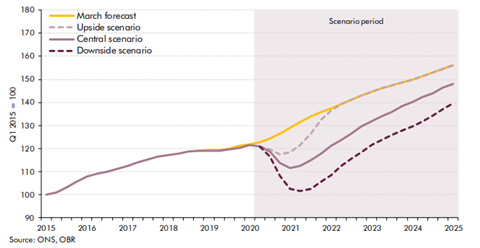Office for Budget Responsibility delivers May forecast
Housing transactions in 2020 will be around 40% below what was expected pre-coronavirus, according to the latest Office for Budget Responsibility figures.
The OBR’s central scenario, which is its most likely predicted outcome, assumes that around half the lost transactions return over the next two years, and that the lockdown-related pause in housebuilding reduces housing supply.
These two factors mean that the total number of transactions over five years are around 4% lower than were forecast in March.

In March the OBR predicted the economy would take only a couple of quarters to return to its pre-coronavirus levels but is now suggesting this will not take place until the end of 2022 in its central scenario.
The tick-shaped recovery scenario now predicted represents a change from the very steep V-shape recovery scenario expected just three months ago.
The forecast has assumed government investment has and will be hit by disruption in the construction sector this year, and will contract by 8% in 2020, compared to the expansion of 2% that was expected in March.
The central scenario assumes that departments will underspend their budgets in 2020-21 by £10bn more than assumed in the March forecast, because of the lockdown’s impact on construction projects, hiring and procurement plans.
The figures have also predicted a higher unemployment rate than during the 2008/09 recession, with their central scenario predicting 15% of the 9.4 million jobs would be lost. This increases to 20% in the downside scenario.
This means the best-case scenario has the unemployment rate peaking at 9.7%.
HMRC’s statistics for claims from self-employed income support scheme made up to 31 May show that by number and by total value the construction sector has been the largest source of claims, while the sector has furloughed 600,000 jobs.











No comments yet